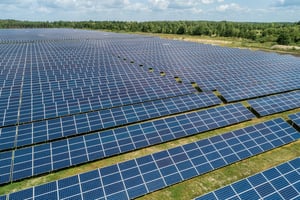Copper plays a crucial role in the operation and efficiency of data centers, particularly in power...
Harnessing Copper’s Sustainability Benefits for Electrical Equipment Manufacturing
The shift towards sustainability in U.S. manufacturing has become not just a matter of compliance but a strategic advantage. Today’s regulatory landscape, including the U.S. Environmental Protection Agency's Clean Power Plan and the SEC’s climate disclosure rules, is driving manufacturers to adopt greener practices across the board. At the same time, consumer expectations are evolving — over 70% of American consumers report that they are more likely to purchase from companies with strong environmental policies.
This shift underscores the market’s preference for sustainable solutions, encouraging manufacturers to incorporate materials that enhance energy efficiency, reduce waste, and support a circular economy. Beyond regulatory and consumer pressures, studies have shown that companies prioritizing sustainability often see improved financial performance, with higher ESG scores positively correlated with Return on Equity, Return on Assets, and overall operational efficiency.
Growing Focus on Sustainability and Responsible Sourcing
As electrical equipment manufacturers strive to meet environmental targets and adapt to a more eco-conscious market, selecting sustainable materials has become essential. Choosing the right materials impacts a product’s environmental footprint and enhances its efficiency and longevity. There are several key considerations manufacturers should keep in mind:
- Energy Efficiency: Sustainable materials should contribute to the overall energy efficiency of electrical equipment, reducing energy consumption throughout its lifecycle.
Image Source: Future Recycling
- Recyclability: Materials that are easily recyclable without a loss in quality support the principles of a circular economy.
- Durability and Longevity: Long-lasting materials reduce the need for frequent replacements, conserving resources and reducing waste over time.
- Environmental Impact of Production: Manufacturers should evaluate the environmental footprint of material extraction and processing, considering factors like carbon emissions, water use, and waste generation. Responsibly sourced and recycled materials often have a lower impact, aligning with sustainability goals and reducing the overall environmental costs of production.
- Regulatory Compliance: As environmental regulations become more stringent, manufacturers need to ensure that their material choices comply with both local and international standards, such as the EU’s Restriction of Hazardous Substances (RoHS) directive or the U.S. Environmental Protection Agency’s guidelines. Choosing sustainable materials that meet these standards helps manufacturers avoid costly penalties and supports long-term compliance.
- Supplier Transparency and Ethical Sourcing: It is increasingly important to collaborate with suppliers committed to ethical and sustainable practices. This includes adherence to responsible mining practices, fair labor conditions, and environmental stewardship.
- Support for Renewable Energy and Clean Technology: As the industry moves toward renewable energy and clean technology, materials that enable these systems are essential.
By considering these factors, electrical equipment manufacturers can make informed decisions that align with their sustainability objectives and market demands, ultimately producing efficient, durable products in line with responsible manufacturing practices.
Copper in Electrical Equipment Manufacturing
A wide range of materials can be specified for electrical equipment, each with unique properties that cater to different performance and sustainability needs and offer distinct advantages. By selecting the right materials, manufacturers can optimize the performance, lifespan, and sustainability of their products, aligning with regulatory requirements and market demands for responsible manufacturing.
Copper has emerged as a cornerstone material in sustainable manufacturing. Since the Paris Agreement in 2015, copper’s role in the energy transition has expanded significantly. Electric vehicles now use 3-4 times more copper than traditional cars, and recycling copper is becoming a major energy saver.
Electrical components' reliability and performance heavily depend on copper use. Its ability to withstand thermal fluctuations without significant expansion helps maintain connection integrity, reducing the risk of failure over time. Unlike other materials that can require protective plating for lower voltage applications, copper can perform effectively without additional coatings at voltages below 600V. This intrinsic robustness allows copper to excel in demanding environments, making it the material of choice for transformers, switchgear, panel boards, and electric motors—especially where efficiency and compact design are paramount.
Copper’s durability and corrosion resistance extend the lifespan of products, reducing the need for replacements and minimizing waste. Its role in renewable energy infrastructure, such as solar panels and wind turbines, is essential in advancing a low-carbon economy. Specifying copper allows for enhanced energy efficiency, product longevity, and sustainability, achieving compliance and meeting market demand for eco-friendly solutions in today’s competitive market.
Benefits of Responsible Sourcing
Responsible sourcing has become a pillar of sustainable practices, especially for copper. Manufacturers can leverage copper's performance benefits while supporting circularity by adopting innovative methods to reduce the carbon footprint associated with refining and production. Copper’s high recyclability allows it to be reused indefinitely, and advanced smelting technologies enable the recycling of diverse inputs, including scrap and electronic waste, enhancing recycling rates and minimizing reliance on virgin materials. Prioritizing responsible sourcing can help manufacturers build a resilient supply chain, reduce regulatory risks, and increase customer loyalty. Manufacturers can produce eco-friendly products that meet rising consumer expectations for sustainable solutions through closed-loop recycling systems and copper's inherent durability.
Copper as a Driver of Sustainable Innovation
As efficiency standards rise and electrification expands, copper’s role in electrical equipment manufacturing will continue to grow. Copper’s properties, from high conductivity to durability, make it essential for managing increased power loads while minimizing waste, solidifying its position as a critical material in modern electrical engineering. By embracing copper's sustainability benefits, manufacturers can achieve regulatory compliance, reduce environmental impact, and maintain a competitive edge in an eco-conscious market. In a rapidly evolving industry, copper enables transformative strategies that support a sustainable future, ensuring that manufacturers can meet both performance demands and sustainability goals, reinforcing the importance of responsible manufacturing for years to come.



